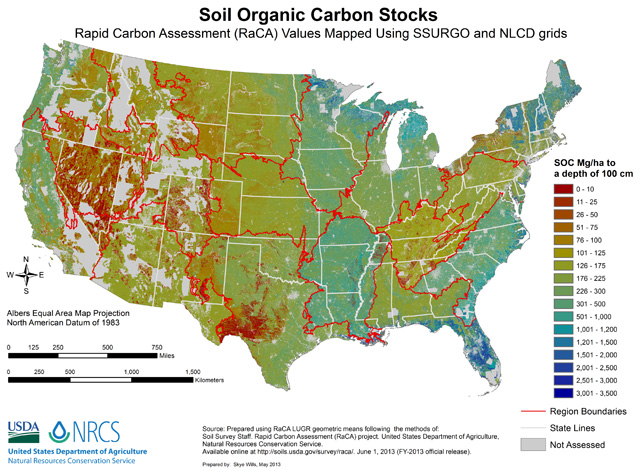Source: USDA Natural Resources Conservation Service
WASHINGTON, July 1, 2013 — USDA’s Natural Resources Conservation Service (NRCS) has developed the world’s largest soil carbon dataset to help producers and planners estimate the impacts of conservation practices on soil carbon levels. USDA is committed to reducing agriculture’s carbon footprint, as Agriculture Secretary Tom Vilsack discussed in a June 5 address at the National Press Club in Washington, D.C. The Secretary outlined USDA’s modern solutions for environmental challenges.
“It is our obligation to equip landowners with the most up-to-date information and technical assistance so we can mitigate the impacts of climate change and help secure sustainable food production systems for the American people,” said NRCS Acting Chief Jason Weller.
Soil has tremendous potential to store carbon, which reduces the levels of carbon dioxide in the atmosphere, one of the leading greenhouse gases contributing to climate change.
Storage potential varies among soils, land covers, land uses and management, and NRCS soil scientists took 148,000 individual soil samples and evaluated them for carbon content. This Rapid Carbon Assessment, or RaCA, dataset serves as a baseline or snapshot in time for the amount of carbon each soil type is holding.
“By understanding our soils’ current carbon content, we can target the ones with the greatest potential to store additional carbon. Planners can use models (where accuracy is enhanced by RaCA data) to better predict the impact a conservation practice might have on enhancing the soil’s carbon content,” Christopher Smith, NRCS soil scientist, said.
Increasing soil carbon is also the single most important component of soil health, Smith said.
Several conservation practices, such as conservation crop rotations or planting cover crops, help increase carbon storage in soil. These crops take carbon dioxide out of the atmosphere and deposit it into the soil as organic matter. They also help reduce erosion and increase water-holding capacity and water infiltration, which increases the resiliency to drought, heavy precipitation and extreme temperatures.
Landowners can calculate how much carbon their conservation practices such as cover crops can remove from the atmosphere with the new tools, COMET- Farm™ and the Agricultural Policy Environmental Extender, or APEX model.
COMET- Farm™, developed in partnerships between USDA and Colorado State University, is a free online tool that allows producers to enter information about their farm or ranch management practices and receive general guidance on actions they can take to build carbon in their soil.
APEX, developed in partnership with Texas Agrilife Research, Texas A&M, and USDA’s Agricultural Research Service and NRCS, is planned for use by NRCS conservation planners and private technical service providers. This tool will also assist NRCS and landowners with properly managing nutrients to keep a balance between soil carbon gains, production goals and impacts on water quality.
The Rapid Carbon Assessment, COMET- Farm™ and APEX open the door to new possibilities for producers, said Dr. Adam Chambers, scientist with the NRCS air quality and atmospheric change team in Oregon.
If carbon can be quantified, verified, and then sold into carbon markets, it is “another potential revenue stream for producers,” said Chambers.
As of Jan. 1, California began regulating a cap and trade carbon credit market for industries. The first to do so, the state is looking for agricultural greenhouse gas emission reduction and carbon sequestration projects to provide offsets into their regulated markets, he said.
“The Rapid Carbon Assessment provided baseline data on how much carbon is in each soil type. COMET-Farm™ can then be used to show how different management practices can increase that soil carbon,” said Chambers, who is guiding the work in environmental markets for the agency through NRCS Conservation Innovation Grants programs.
To find more information on COMET- Farm™, APEX, the Rapid Carbon Assessment and how NRCS can help you mitigate climate change, visit your nearest NRCS field office.
USDA’s Natural Resources Conservation Service helps America’s farmers and ranchers conserve the Nation’s soil, water, air and other natural resources. All programs are voluntary and offer science-based solutions that benefit both the landowner and the environment.


